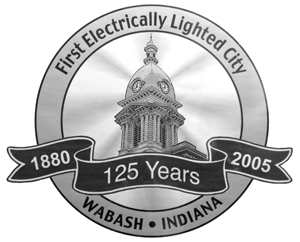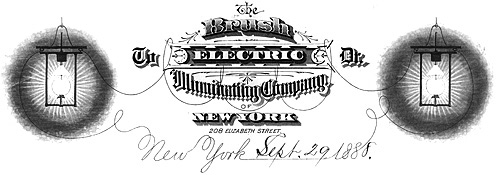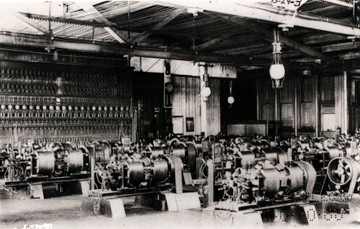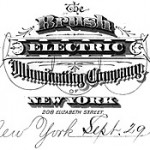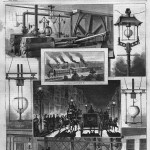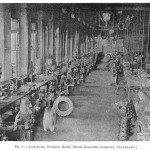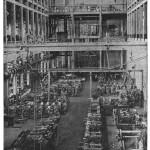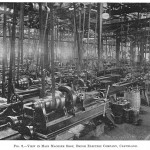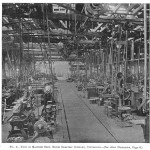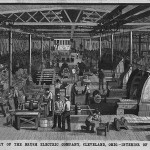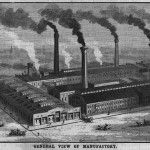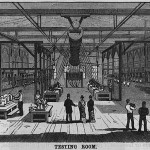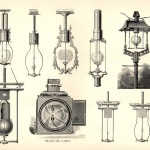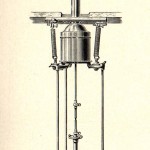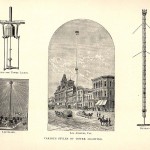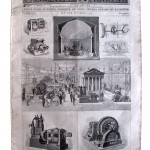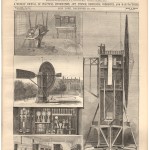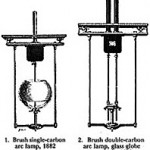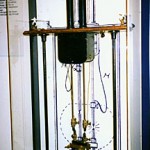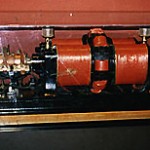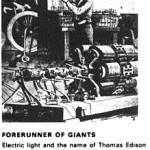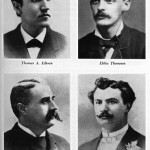Philadelphia 1878
“Miniature moons on carbon points, held captive in glass globes”
A description of the “wonder of 1878”: an installation of Brush arc lamps in the window of Wanamaker’s department store in Philadelphia.
Cleveland Ohio 1879
“Thousands of people gathered…and as the light shot around and through the Park a shout was raised. Presently the Grays Band struck up in the pavilion, and soon afterward a section of artillery on the lake shore began firing a salute in honor of the occasion.” “The Telegraph Supply Company’s establishment…was thrown open to as many people as could be accommodated at a time to go through the works and inspect the machinery which sends light over the wire to blaze out between the carbon points in the lamps.” Excerpts from the Cleveland Plain Dealer describing the lighting of a park in Cleveland Ohio with Brush arc lamps on April 29, 1879 (from Men&Volts: The Story of General Electric).
Wabash Indiana 1880
“Promptly as the courthouse clock struck eight, the thousands of eyes that were turned upward toward the inky darkness over the courthouse saw a shower of sparks emitted from a point above them, small, steady spots of light, growing more brilliant until within a few seconds after the first sparks were seen, it was absolutely dazzling. A loud shout went up from the crowd, and the band began to play…” “People stood overwhelmed with awe, as if in the presence of the supernatural. The strange, weird light, exceeded in power only by the sun, rendered the square as light as midday. Men fell on their knees, groans were uttered at the sight and many were dumb with amazement. We contemplated the new wonder in science as lightning brought down from the heavens.” Excerpts from newspaper accounts describing the lighting of Wabash Indiana in 1880 with four 3,000 candlepower Brush arc lamps suspended over the courthouse. (from Men&Volts: The Story of General Electric) These were powered by a small dynamo outside the court house, which was connected to a threshing machine’s steam engine. One of the original lamps is still on display in the court house lobby. This event earned Wabash the title of the first city wholly lit by electric light.
New York City 1880
Books on the history lighting often state that Edison’s Pearl Street station was the first central station in New York City (or anywhere) powering the first electric lights. The problem is that a full two years earlier Brush arc lights were lighting sections of Broadway, and by 1881 there were large central stations set up for arc street lighting. The April 1881 issue of Scientific American featured a cover story on the Brush system in New York and it has some great illustrations of the giant steam engines powering rows of dynamos. Many other large cities had similar plants.
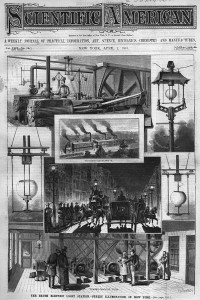
Background
Wabash was the first city to be lit solely by electricity and to own its own municipal power plant (that small dynamo driven by a threshing machine engine). The installation in Cleveland the year before in 1879 had been a demonstration, but Cleveland would soon begin lighting its streets with arc lamps as well. In 1876 Charles F. Brush invented a new type of simple, reliable, self-regulating arc lamp, as well as a new dynamo designed to power it. Earlier attempts at self regulation had often depended on complex clockwork mechanisms that, among other things, could not automatically re-strike an arc if there were an interruption in power. The simpler Brush design used a solenoid combined with a clutch mechanism to adjust the carbons over their entire length. Combined with improvements like an automatic shunt coil to remove a failed lamp from the main circuit, double carbons which could burn all night, and plated carbons for improved conductivity, this lamp/dynamo system made central station lighting a possibility for the first time. In the late 1870’s Brush arc lamp installations were being purchased by individuals, department stores, theaters, and factories. The largest of these was an 80 lamp installation in a mill. 1880 saw the first larger scale commercial use of arc lamps for street lighting as Brush plants, and eventually those of competitors like Thomson-Houston, were established in a number of large cities throughout the US. The letterhead at the top of this page is from a bill from a local Brush utility to the City of New York for street lighting. In 1880 Brush successfully demonstrated arc lighting along Broadway, and soon thereafter built New York’s first central station. Similar systems were installed all over the world. Companies like Thompson-Houston were quick to jump into the business once it had been proven profitable, and based their designs closely on Brush patents adding slight modifications. Thomson-Houston was sucessful enough that they eventually purchased Brush, and through a merger with the Edison companies formed General Electric. GE continued to manufacture Brush, Thomson-Houston, and Edison equipment for many years before combining it all into the GE product line. Arc lamps survived for decades despite the predominance of incandescents. They were simply much brighter and better suited to certain applications.
Archives
Click any image for a larger version
Links
Ancestors of Charles F. Brush and his early years

